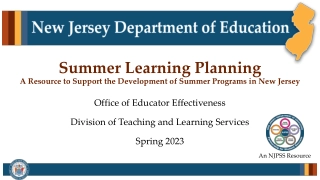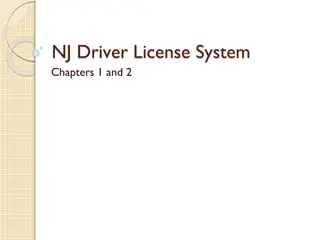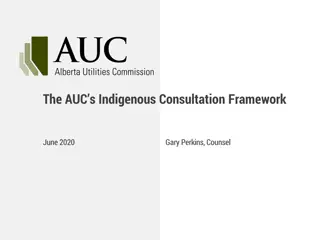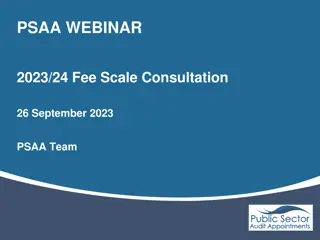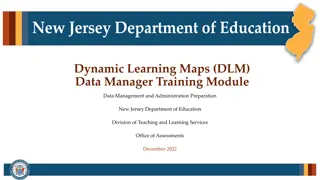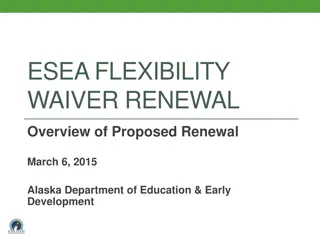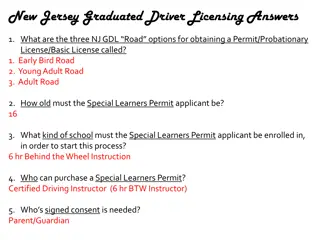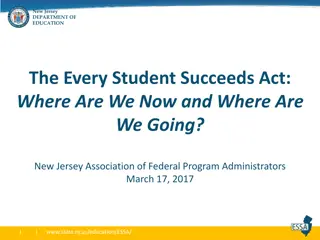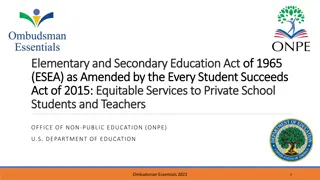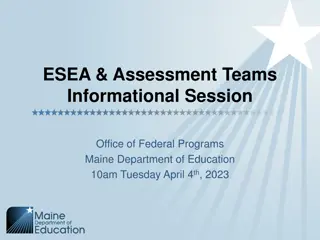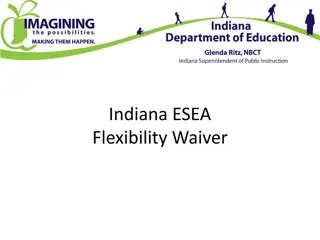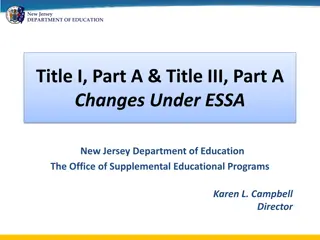New Jersey Department of Education ESEA Consultation Requirements
The New Jersey Department of Education outlines the roles and responsibilities for providing equitable services to nonpublic schools under ESEA guidelines. This includes the responsibilities of the State Education Agency, Local Districts, and Nonpublic Schools in ensuring fair access to educational services. Consultation topics, necessary documentation, and complaint processes are also highlighted in this comprehensive overview.
Download Presentation

Please find below an Image/Link to download the presentation.
The content on the website is provided AS IS for your information and personal use only. It may not be sold, licensed, or shared on other websites without obtaining consent from the author. Download presentation by click this link. If you encounter any issues during the download, it is possible that the publisher has removed the file from their server.
E N D
Presentation Transcript
New Jersey Department of Education ESEA Consultation Requirements for the Provision of Nonpublic Equitable Services April 2020 Constance Webster, Ph.D. ESEA Nonpublic Ombudsman
Mission The New Jersey Department of Education supports schools, educators and districts to ensure all of New Jersey's 1.4 million students have equitable access to high quality education and achieve academic excellence. 2
Agenda Roles and Responsibilities Role of State Education Agency (SEA) Role of Local District (LEA) Role of Nonpublic School (NP) Consultation Outreach Topics Considerations ESEA sections 1117(b)(1) and 8501(c)(1) 3
NJDOE (SEA) Responsibilities Overview Designate an ombudsman to monitor and enforce ESEA equitable service requirements and collect affirmation of consultation documentation Provide notice of allocations to nonpublic schools Investigate and resolve formal complaints ESEA Complaint Process (ESEA Sections 1117(a)(3)(B) and 8501(a)(3)(B) 4
LEA Responsibilities Overview Conduct and document timely and meaningful consultation ESEA sections 1117(b) and 8501(c) Allocate funds for providing equitable services ESEA sections 1117(a)(4)(A) and 8501(a)(4)(A) Have a goal of reaching agreement ESEA sections 1117(b)(1) and 8501(c)(1) Provide services that meet the needs of students and teachers ESEA sections 1117(a)(1)(A) and 8501(a)(1) Assess services ESEA sections 1117(b)(1)(D) and 8501 (c)(1)(D) Obligate funds in the year they are received ESEA sections 117(a)(4)(B) and 8501(a)(4)(B) 5
Nonpublic School Responsibilities Overview Participate in consultation Have a goal of reaching agreement Provide necessary documentation to LEA Participate in program assessment 6
Consultation Topic Required Topics General Overview Educational services and other benefits provided for nonpublic school children, teachers, and other educational personnel shall be equitable in comparison to services and other benefits for public school children, teachers, and other educational personnel and shall be provided in a timely manner. 7
Consultation Consultation is the key to successful implementation of federal equitable service requirements. Begins in the Spring prior to the upcoming school year. The goal of consultation is agreement between the local education agency and nonpublic school officials on how to provide equitable and effective programs for eligible nonpublic school children. 8
ESEA Consultation Toolkit Every form referenced in this workshop is posted on the link below ESEA Nonpublic Consultation Toolkit 9
Consultation Outreach (1 of 3) Which nonpublic school(s) does an LEA contact? All nonpublic schools within the LEA s sending area that are not for profit and registered with the NJDOE Nonpublic school directory Example: ATLANTIC (02) ENGLISH CREEK ACADEMY (0012-12A) 600 SCARBOROUGH DRIVE EGG HARBOR TWP, NJ 08234 FOR-PROFIT LAURA PAPPAS, OWNER ENGLISHCREEKACADEMY@COMCAST.NET (609)645-9800 Public School District: EGG HARBOR TWP (1310) 10
Consultation Outreach (2 of 3) An LEA must also contact nonpublic schools outside the district if the LEA suspects students who reside in one of its Title I attendance areas are enrolled in a nonpublic school beyond the district s boundaries. (for Title I purposes only) Locating NP school students If a nonpublic school believes it has students who may be eligible for services and has not been contacted by the LEA, the nonpublic school should contact the LEA directly. NP requesting consultation 11
Consultation Outreach (3 of 3) What does the LEA send to nonpublic schools before the consultation process? Request for Consultation letter Nonpublic School Request for Consultation Letter ESEA Affirmation of Consultation Affirmation of Consultation Copy of Refusal of Funds Refusal of Funds Affirmation 12
Consultation Outreach (Title I- Specific) (1 of 4) Nonpublic School Family Survey Nonpublic Schools send the school family survey letter to their families along with the eligibility guidelines. This information is provided to the LEA, which helps determine proportionate share of Title I funds for nonpublic school. 13
Consultation Outreach (Title I- Specific) (2 of 4) ESEA section 1117(b)(1)(F) requires an LEA to consult with appropriate nonpublic school officials regarding the availability of low-income data. Section 1117(a)(4)(D) allows an LEA to collect this data annually or biennially. Due to the difficulty some nonpublic schools may have in collecting low-income data from their families the Department recommends offering NP schools the option of using last year s low-income data to determine eligibility. 14
Consultation Outreach (Title I- Specific) (3 of 4) Nonpublic School Family Survey (Title I Only) 15
Consultation Outreach (Title I- Specific) (4 of 4) Income determines the funding generated for Title I equitable services LEA gets these numbers from the results of parent survey. The number of low-income students is used as part of the calculation which generates a per pupil amount for each student eligible for Title I services. Services provided are based on academic need. They do not have to be the same students. All NP students served with Title I funds must live in a public school sending area that is served with Title I funds. 16
Consultation Outreach: Deadlines Can an LEA set a deadline for nonpublic schools to indicate intent to participate? Yes An LEA may set a reasonable deadline, taking into consideration nonpublic schools schedules, to indicate their intent to participate. An LEA should provide clear and sufficient notice of the deadline, identifying potential consequences for not meeting the deadline, and give adequate time for nonpublic schools to respond. 17
Consultation Outreach: Non-Responsive Schools Non-Responsive Schools What should an LEA do if a nonpublic does not respond to multiple consultation requests? An LEA must retain documentation showing proof multiple attempts to engage the nonpublic school in consultation were made. This can include the following: Read receipt email Certified letter Phone log Upon request, an LEA must provide access to this documentation. 18
Consultation Required Topics How needs will be identified Size and scope of services Amount of funds for services available and how they are determined What services will be offered How, where, and by whom services will be provided Delivery of services, including whether to use a third-party contractor How services will be assessed and the results used to improve services Pooling of funds Whether to use funds in coordination with funds available under other programs 19
Consultation Required Topic: Services to be Provided Program(s) are driven by outcome of data supported Needs Assessment Program(s) are determined during spring consultation Program(s) are continuously evaluated for effectiveness Scope of program can change during grant cycle On-going consultation captures program implementation and effectiveness 20
Consultation Topic Required Topic: Needs Assessment To be completed by the nonpublic school prior to initial consultation meeting Should reflect use of equitable share in each eligible Title Use of funds should be supported by data: Achievement tests Teacher referrals Recommendations based on objective, educationally related criteria Grades These criteria may be different than those used by the LEA 21
Consultation Topic Required Topic: Size and Scope of Services Nonpublic ESEA Allocation Tables Public ESEA Allocation Tables These tables are updated as soon as the NJDOE gets the ESEA allocation from the Federal government. A nonpublic school must fill out the Nonpublic Enrollment Report on time in order to receive an equitable share of federal funds. Proceed with consultation using 85% of the prior year s allocation. 22
Consultation Required Topic: Service Delivery (1 of 2) How? Where? By Whom? An LEA may provide services directly or indirectly through contracts with individuals and public and private agencies, organizations, and institutions so long as those entities are independent of the nonpublic school in the provision of those services. 23
Consultation Required Topic: Service Delivery (2 of 2) Use of Third-Party Provider Consultation must include a discussion of service delivery mechanisms. LEA must include a thorough consideration and analysis of the views of the nonpublic school officials on the provision of services by potential third-party providers. The LEA remains responsible for the oversight of the programs. 24
Consultation Required Topic: Coordination of ESEA Funds (1 of 2) Often funds available under Title I and/or Title VIII programs are not sufficient to provide robust equitable services under each program alone. Coordinating the use of Title I funds with funds available from Title VIII programs eliminates the silo approach in which an LEA consults with nonpublic school officials on each program separately. 25
Consultation Topic Required Topic: Coordination of ESEA Funds (2 of 2) Example Through coordination, a nonpublic school with limited Title I funds receives instructional services for Title I eligible nonpublic students; uses Title II funds to obtain professional development for the students teachers (as opposed to all teachers in a given school); uses Title III funds to improve the English proficiency of English learners among the participating students; and uses Title IV funds to provide necessary counseling services to the most-at-risk eligible students. 26
Consultation Required Topic: Transferability (1 of 2) An LEA may transfer some or all of its Title IIA and or IV funds into the following Titles: Title I, Part A Improving Basic Programs Operated by Local Educational Agencies Title I, Part C Education of migratory children Title I, Part D Prevention and intervention programs for children and youth who are neglected, delinquent, or at-risk Title II, Part A - Supporting Effective Instruction Title III, Part A - English Language Acquisition, Language Enhancement, and Academic Achievement Title IV, Part A - Student Support and Academic Enrichment Grants Title V, Part B Rural Education 27
Consultation Required Topic: Transferability (2 of 2) The transferred funds assume the characteristics of the Title into which the funds are transferred. Before an LEA transfers funds it must consult with its nonpublic school partners. 28
Consultation Required Topic: Pooling (1 of 2) Option 1: Within an LEA Among Nonpublic Schools Provide equitable services to eligible children attending a nonpublic school that is part of a group of nonpublic schools under the authority of a single organization by pooling the funds. 29
Consultation Required Topic: Pooling (2 of 2) Across LEAs Because eligibility for Title I services is based on a child s residence and not where the child attends school, multiple LEAs may have a responsibility to provide services to eligible children who attend the same nonpublic school . This makes pooling across LEAs potentially more educationally effective and efficient rather than each LEA providing services to eligible students in the same nonpublic school. Low-achieving nonpublic school children in greatest need who reside in a participating Title I public school attendance area in any of the applicable LEAs may be served with the pooled funds. 30
Consultation Considerations: Obligation of Funds (1 of 2) Funds allocated to an LEA for educational services and other benefits to eligible nonpublic school children shall be obligated in the fiscal year for which the funds are received. The applicable fiscal year is the Federal fiscal year, which ends September 30 of each year. ESEA sections 1117(a)(4)(B) and 8501(a)(4)(B) 31
Consultation Considerations: Obligation of Funds (2 of 2) Can an LEA impose reasonable deadlines on nonpublic schools to meet the obligation of funds requirement? Yes. An LEA is responsible for ensuring that ESEA funds are obligated in a timely manner. Nonpublic schools must participate in this process. A deadline is established in consultation to obligate funds for equitable services. 32
Consultation Considerations: Carryover Funds Funds allocated to an LEA for educational services and other benefits to eligible nonpublic school children shall be obligated in the fiscal year for which the LEA receives the funds. There may be extenuating in which an LEA is unable to obligate all funds circumstances within the timeframe. Under these circumstances, funds may remain available for the provision of equitable services under the respective program during the subsequent school year. 33
Thank You! New Jersey Department of Education Website https://www.nj.gov/education/ Constance Webster, PhD ESSA Nonpublic Ombudsman Office of Nonpublic School Services New Jersey Department of Education 609-376-3662 ombudsman.nonpublic@doe.nj.gov Follow Us! Facebook: @njdeptofed. Twitter: @NewJerseyDOE. Instagram: @NewJerseyDoe New Jersey Department of Education (@njdeptofed) @NewJerseyDOE @NewJerseyDoe 34


